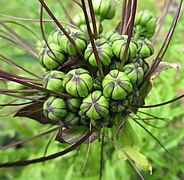Tacca leontopetaloides
| Polynesian arrowroot | |
|---|---|

| |
| Scientific classification | |
| Kingdom: | Plantae |
| Clade: | Tracheophytes |
| Clade: | Angiosperms |
| Clade: | Monocots |
| Order: | Dioscoreales |
| Family: | Dioscoreaceae |
| Genus: | Tacca |
| Species: | T. leontopetaloides
|
| Binomial name | |
| Tacca leontopetaloides | |
| Synonyms[3] | |
| |
Tacca leontopetaloides is a species of
History of cultivation
Polynesian arrowroot is an ancient
Polynesian arrowroot was a minor staple among Austronesians. The roots are bitter if not prepared properly, thus it was only cultivated as a secondary crop to staples like
Description

The tubers are round, hard and potato-like, with a brown skin and white interior.[4][5] In December, the plant is dormant, the leaves and stalks dry up and die down to the ground until March when new leaves grow back.[9]: 387
The leaves are "palmately incised and/or divided into 3-13 lobes, each lobe pinnately divided into numerous smaller ones".[9]: 401 Several petioles 17–150 cm (6.7–59.1 in) in length extend from the center of the plant which look like giant celery, on which the large leaves (30–70 cm or 12–28 in long and up to 120 cm or 47 in wide) are attached.[5] The leaf's upper surface has depressed veins, and the under surface is shiny with bold yellow veins.
Umbels
The fruit emerges from the bracts, each fruit are globular 4–5 cm long.[4][5] The fruits ripen and turn from pale or dark green to pale orange. Each fruit produces many flat, ribbed and yellowish brown seeds 5–8 mm long.[9]: 378
-
Inflorescence (umbel)
-
Flower with 6 tepals, 6 stamens and 3-lobed stigma
-
Infructescence
Uses
The tubers of Polynesian arrowroot contain
The starch was additionally used to stiffen fabrics, and on some islands, the stem's bast fibres were woven into mats.
In traditional Hawaiian medicine the raw
See also
Notes
- ^ Contu, S. (2013). "Tacca leontopetaloides". IUCN Red List of Threatened Species. 2013: e.T44392847A44503085. Retrieved 22 February 2023.
- ^ a b "Tacca leontopetaloides". Germplasm Resources Information Network. Agricultural Research Service, United States Department of Agriculture. Retrieved 2009-11-17.
- ^ "Tacca leontopetaloides (L.) Kuntze". World Flora Online. World Flora Consortium. 2023. Retrieved 11 March 2023.
- ^ a b c d e "Tacca leontopetaloides (Dioscoreaceae)". Meet the Plants. National Tropical Botanical Garden. Archived from the original on 5 October 2010. Retrieved 17 November 2009.
- ^ a b c d e Tan, Ria (13 January 2022). "Seashore bat lily (Tacca leontopetaloides)". Wild Singapore. Retrieved 11 March 2023.
- ^ hdl:1885/159550.
- ^ Spennemann, Dirk H.R. (1994). "Traditional Arrowroot Production and Utilization in the Marshall Islands". Journal of Ethnobiology. 14 (2): 211–234.
- ISBN 9789820201064.
- ^ a b c d Drenth, E. (1972). "A revision of the family Taccaceae". Blumea. 20 (2): 367–406.
- ^ Brennan 2000, pp. 252–267
References
- Brennan, Jennifer (2000). Tradewinds & Coconuts: A Reminiscence & Recipes from the Pacific Islands. Periplus. ISBN 962-593-819-2..
External links
![]() Media related to Tacca leontopetaloides at Wikimedia Commons
Media related to Tacca leontopetaloides at Wikimedia Commons




